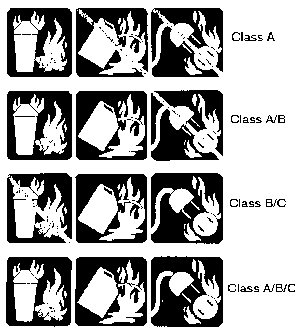 This image came from http://www.osha-slc.gov/doc/outreachtraining/htmlfiles/extmark.html
This image came from http://www.osha-slc.gov/doc/outreachtraining/htmlfiles/extmark.html
Fire Classifications
Class A: Fires that involve wood, cloth, rubber, paper, and some types of plastics.
Class B: Fires that involve gasoline, oil, paint, natural and propane gases,
and flammable liquids, gases, and greases.
Class C: Fires that involve all the materials found in Class A and B fires, but
with the introduction of an electrical appliances, wiring, or other electrically
energized objects in the vicinity of the fire.
Class D: Fires that involve combustible metals, such as sodium, magnesium, and
potassium.
Classes of Fire
Use The Right Portable Fire Extinguisher
Allan B. Colombo http://www.tpromo.com/ssmag/fire/saft4.htm
If a fire broke out in your home today, would you automatically know which fire extinguisher to use? What would happen if you used a Class A fire extinguisher on a fire in the electrical service panel in your basement? Answer: you'd possibly be electrocuted if the extinguishing agent is a liquid!
A long time ago, the fire protection industry recognized the need to classify extinguishers according to the many kinds of burning materials encountered in a fire. For example, Class A, water-type fire extinguishers cannot be used on the electrical fires because the extinguisher operator could be seriously injured by the conduction of electricity by the stream of water from their extinguisher. Instead, a Class C fire extinguisher will work best. Another example, a raging fire in a manufacturing plant with flammable metals, such as magnesium, should be fought with a Class D fire extinguisher.
Besides knowing what type of fire you're likely to encounter, it's also important to know what kind of extinguishing agent your fire extinguisher should have in it. This is because certain extinguishments will work only on certain kinds of fires. Others can actually aggravate the situation, causing an even more critical situation.
For example, a WATER agent should only be used on Class A fires. This is because they put out fires by cooling, soaking and penetrating combustible materials. A REGULAR DRY CHEMICAL agent should only be used on Class B and C fires. This is because they attempt to interrupt the fire's flame by interfering with the fuel-oxygen-heat triangle instead of simply cooling a fire. A MULTIPURPOSE DRY CHEMICAL, however, can be used on Class A, B, and C fires. This is because the extinguishing agent melts when it's exposed to heat, forming an oxygen barrier over the burning materials.
CARBON DIOXIDE, another popular extinguishment, should also be used on Class B and C fires. They put out fires by cutting off the air supply, virtually choking a fire. FOAM agents also cut off a fire's oxygen supply, but they should only be used on Class A and B fires.
DRY POWDER agents are good only on Class D fires. Do not use dry powder for Class A, B, and C fires. This is because they specifically form a coating agent over the burning metals, suffocating the flame.
Obviously, most of the time there are more than one type of materials found in each area of a home. For instance, in a basement you're likely to find cloth; wood; an electrical panel box; electric, oil or a gas furnace; and an electric or gas hot water tank. In this case, buying a Class A/B/C extinguisher would be advisable.
Another example is the kitchen area where you're likely to find flammable liquids (grease) and gases (propane or natural gas). In addition, you'llusually find various electrical appliances. In this situation, it is probably more economical to buy Class B/C extinguisher instead of keeping separate Class B and C extinguishers in these areas. Class A extinguishers also are good